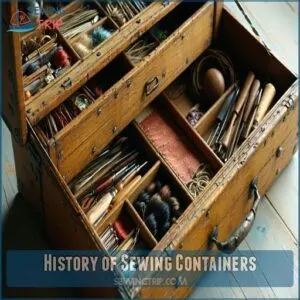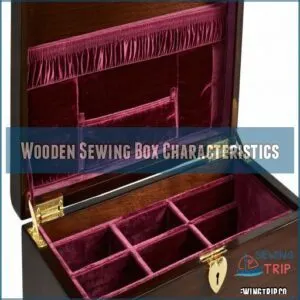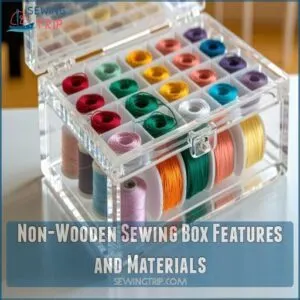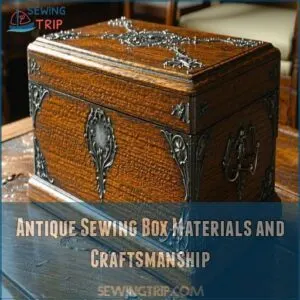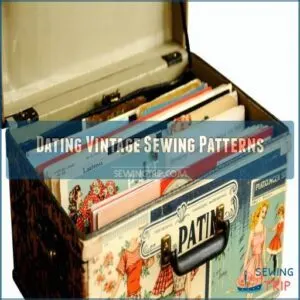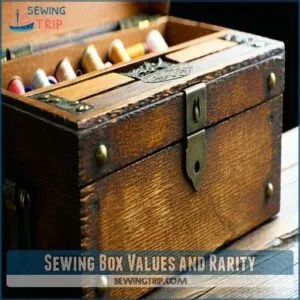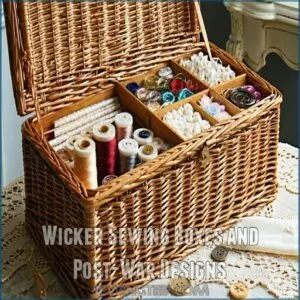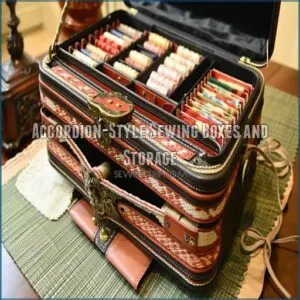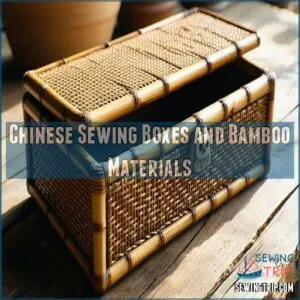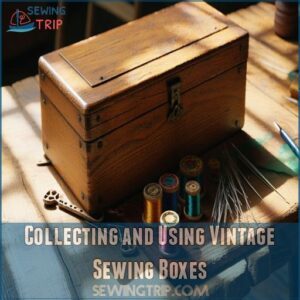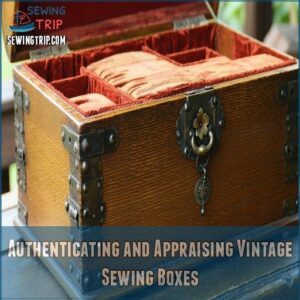This site is supported by our readers. We may earn a commission, at no cost to you, if you purchase through links.
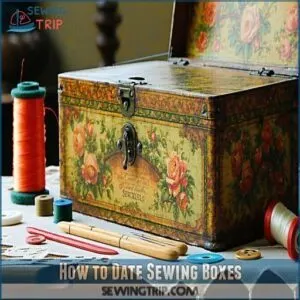 Dating vintage sewing boxes is an engaging puzzle you can unravel.
Dating vintage sewing boxes is an engaging puzzle you can unravel.
Examine the construction techniques, materials, and hardware to identify the era.
Look for telltale signs like wood types, metal fasteners, and ornate details.
Wooden boxes from the early 1900s may feature dovetail joints, while mid-century designs incorporate sleek, modern lines.
Pay close attention to logos, fonts, and labels – they hold clues about the manufacturer and time period.
With some detective work, you’ll discover if that sewing box is a century-old antique or a retro-inspired vintage find.
The thrill is in the hunt, so start sleuthing and uncover the history behind your sewing box today!
Table Of Contents
- Key Takeaways
- History of Sewing Containers
- How to Date Sewing Boxes
- Types of Sewing Boxes
- Dating Vintage Sewing Patterns
- Sewing Box Values and Rarity
- Popular Vintage Sewing Box Styles
- Collecting and Using Vintage Sewing Boxes
- Authenticating and Appraising Vintage Sewing Boxes
- Frequently Asked Questions (FAQs)
- Conclusion
Key Takeaways
- Examine the materials, designs, and logos of vintage sewing boxes to pinpoint their era – from ornate wooden boxes to mid-century modern plastic ones.
- Look for era-specific clues like dovetail joints, sleek lines, and branded fonts to uncover the history behind your sewing box treasures.
- Understand how factors like condition, rarity, and provenance impact the value of vintage sewing boxes to make informed collecting decisions.
- Repurpose and display your vintage sewing box collection to add a charming, nostalgic touch to your sewing space or home decor.
History of Sewing Containers
The history of sewing containers is a fascinating journey through time.
From the earliest fabric and leather pouches to the ornate, jewel-encrusted boxes of the wealthy, these functional items have evolved to reflect the changing styles and needs of sewers across the centuries.
Early Sewing Containers and Materials
Imagine ancient times when sewing containers were little treasures made from fabric and leather, often featuring portable sewing essentials. They embraced a creative mix of materials to hold your stitching tools close.
These containers featured:
- Fabric and leather construction: Soft yet sturdy.
- Bone enhancements: Adding a dash of durability.
- Wooden touches: For the extra charm.
- Basket weave designs: Intricate patterns.
- Simple craftsmanship: Timeless elegance.
Industrialized Era Sewing Box Evolution
The industrialized era ushered in major changes for sewing boxes.
As a result, various sewing box materials became more accessible to the masses, such as those found on websites selling sewing box essentials.
Craftsman-made, ornate containers became more affordable through mass production.
Victorian sewing boxes grew larger, housing an array of tools like scissors, pins, and thread.
Locks on these boxes allowed women to keep personal items private.
Chinese-style baskets also gained traction in the late 1800s.
20th Century Sewing Box Trends
By the 1970s-80s, sewing boxes lost their luster as women entered the workforce.
Wicker or plastic baskets became popular, allowing sewing equipment to blend into the home.
Yet in the late 90s and 2000s, vintage sewing boxes experienced a resurgence as collectors sought out these charming relics.
Today, they offer both function and nostalgic flair.
How to Date Sewing Boxes
Determining the age of your vintage sewing box can be a fun and interesting process.
To authenticate an antique sewing box, examine the craftsmanship, then study the materials, designs, and logos, particularly those associated with vintage Kenmore sewing, to unravel the history and timeline of these classic sewing accessories.
Identifying Era-Specific Materials and Designs
Want to date a vintage sewing box? Let’s get into it!
Knowing the materials and designs helps pinpoint its era.
Look closely—details matter!
| Material | 1800s | 1900s-1950s | 1950s-onward |
|---|---|---|---|
| Primary | Wood, bone, wicker | Wood, wicker, metal | Plastic, metal |
| Common Finishes | Ornate, painted, lacquered | Painted, decals, fabric | Simple, brightly colored |
| Notable Styles | Victorian, Chinese baskets | Art Deco, mid-century modern | Retro, minimalist |
These era-specific clues reveal your box’s history!
Understanding The Evolution of Sewing Box Styles
Uncover the evolution of sewing box styles from the Victorian era to mid-century modern. Wooden boxes gave way to wicker, plastic, and acrylic designs, reflecting changing materials and aesthetics over the decades. Discover the defining features of vintage sewing cabinets, such as the popular Martha Washington Sewing Cabinet with its colonial ball gown design, that can help date and appreciate these charming storage solutions.
- Wicker sewing boxes popular in post-war period
- Accordion-style boxes provided ample storage
- Chinese baskets gained popularity in late 1800s
- Plastic and non-wood materials emerged mid-century
- Vintage sewing boxes offer compact, cozy storage
Examining Logos, Fonts, and Labels
When dating vintage sewing boxes, examining the logos, fonts, and labels can reveal telling clues about their era.
For example, early 20th century Advance patterns featured an Eiffel Tower logo, while 1950s Butterick patterns boasted bold block lettering.
To further authenticate your sewing box, you can also consult online resources that specialize in sew box logo dating.
Paying close attention to design details can help pinpoint the origins of your beloved sewing treasures.
| Brand | 1940s Logo | 1950s Logo | 1960s Logo |
|---|---|---|---|
| Advance | Eiffel Tower | Bold Type | Side Placement |
| Butterick | Side Placement | Colored Box | Top Placement |
| McCall’s | Script Font | Colored Logo | Removed Logo Bar |
Types of Sewing Boxes
From ornate, jewel-encrusted wooden boxes to practical wicker baskets, vintage sewing boxes come in a variety of styles and materials that reflect the changing tides of fashion and functionality over the decades.
vintage home decor, when paired with antique sewing machines like the Singer 201, renowned for precision stitching, understanding the unique characteristics of different sewing box types can help you uncover the history and value of these nostalgic storage solutions.
Wooden Sewing Box Characteristics
Wooden sewing boxes come in a variety of styles, from the ornate, jewel-encrusted boxes of the wealthy to the more practical, mass-produced designs of the industrialized era.
These charming containers often featured fine wood, intricate carvings, and elegant hardware, reflecting the craftsmanship and status of their owners.
Whether adorned with floral motifs or simple in design, vintage wooden sewing boxes add a touch of vintage charm to any sewing room.
Non-Wooden Sewing Box Features and Materials
Beyond wooden options, non-wooden sewing boxes offer an eclectic mix of materials, with some designs rivaling the premium quality and customizable compartments found in high-end options like The Ultimate SewingBox.
- Plastic boxes provide colorful, durable, and lightweight storage.
- Lucite and Acrylic containers add a modern, transparent charm.
- Tin boxes bring a vintage, industrial flair reminiscent of old lunch boxes.
- Leather or faux-leather give an elegant, timeless appeal, merging style with function seamlessly.
Antique Sewing Box Materials and Craftsmanship
Craftsmanship is where antique sewing boxes truly shine.
Imagine the artisans carefully selecting wood types like mahogany or walnut, pairing them with delicate metal embellishments.
These boxes weren’t just containers—they were art.
Think of how every dovetail joint and hand-carved detail told a story, each box a reflection of the era’s intricate craftsmanship and exquisite construction.
Dating Vintage Sewing Patterns
When you’re trying to date vintage sewing patterns, you’ll soon discover that consistency isn’t always a strong suit of their production.
By examining logos, fonts, and instruction sheets, you can uncover clues about their era.
Making your collection more historically accurate and interesting.
Advance Patterns and Logo Variations
When identifying eras in Advance pattern dating, paying attention to logo evolution is key.
The 1930s featured the Eiffel Tower emblem, while the 1940s and 1950s showcased bold header fonts.
In the 1960s, logos shifted to the side for distinction.
Here’s what to look for:
- Eiffel Tower icon (1930s)
- Bold top logo (1940s-50s)
- Side-placed logo (1960s)
Butterick Patterns and Instruction Sheets
Exploring Butterick patterns?
Notice how their envelope design evolved over the decades, offering clues to their era.
Similar to Nelco sewing machines, which were produced between 1953 and 1990, unique features and styles make them a fascinating part of sewing history. Butterick’s unique features and styles make them a fascinating part of sewing history.
These weren’t just any patterns—the introduction of the Deltor in the 1920s revolutionized instruction sheets, simplifying sewing projects.
While pattern numbering varied, it sometimes provides hints on age.
McCall’s Patterns and Script Fonts
Figuring out the secrets of vintage McCall’s patterns can be a fun challenge! Dating these patterns often involves focusing on the details. You’ll want to look for clues like these:
- McCall’s script fonts used in early patterns.
- The logo’s evolution: its placement and changes over time.
- The addition of the "S" to McCall’s in 1952.
- Font changes reflecting different eras.
- Note the color shifts in the logo over the years. This offers great insight into pattern dating.
Simplicity Patterns and Colored Logos
Simplicity Patterns offer a fascinating journey through logo design trends, especially their colored logo variations.
Imagine this: in the 1960s, Simplicity’s pattern changes introduced bold, block letters inside colorful boxes, evolving from earlier script styles.
Such shifts reflect a broader embrace of vibrant pop culture aesthetics.
For vintage pattern enthusiasts, understanding Simplicity’s logo history can be compared to learning beginner sewing skills and selecting beginner-friendly patterns from online resources like making clothes tutorials to understand fashion’s past.
Sewing Box Values and Rarity
With vintage sewing boxes, you’ll find that their value and rarity depend on factors like age, material, and condition.
Understanding these elements can help you identify treasures worth collecting or selling.
Factors Affecting Vintage Sewing Box Values
Determining the value of a vintage sewing box hinges on materials, condition, and maker’s mark.
It’s likely more valuable if it’s crafted from rare wood or features exquisite detailing.
Consider the era; older boxes often carry a heftier price tag.
Keep an eye on its preservation—pristine condition can charm collectors, boosting its allure and worth.
Also consider how effectively it can store and organize sewing supplies, such as organize sewing box essentials.
Identifying Rare and Collectible Sewing Boxes
As you peruse the vintage sewing box market, keep an eye out for a few key identifiers that can signal rarity and collectibility.
Look for unique materials like exotic woods, intricate carvings, or luxury finishes, which are often showcased by vintage sewing box makers.
Unique designs, maker’s marks, and well-preserved condition are also signs of a coveted sewing box treasure.
Evaluating Condition and Authenticity
Figuring out a vintage sewing box’s condition is key to figuring out its authenticity.
Examine it closely for signs of wear, checking the material quality and whether all original parts are intact.
Look for manufacturer marks – these can help verify age and provenance.
Consulting experts is also wise to make sure you have an accurate understanding of your treasure’s worth.
Popular Vintage Sewing Box Styles
From sturdy wooden chests to charming wicker baskets, vintage sewing boxes boast a rich diversity of materials and designs that captivated sewers throughout the 20th century.
Exploring the evolution of these beloved sewing companions offers a glimpse into the history and artistry of this essential craft.
Whether you’re drawn to the intricate details of an antique Chinese bamboo container or the practical storage solutions of an accordion-style box, there’s a vintage sewing box for every taste.
Wicker Sewing Boxes and Post-War Designs
Often found adorning homes in the post-war period, wicker sewing boxes were a practical and aesthetically pleasing storage solution.
Frequently left unpainted or covered in inexpensive cotton prints, these vintage containers embodied the casual charm of mid-century design.
Their woven construction provided ample space for storing sewing essentials, making them a popular choice for sewers of the 1950s and 1960s.
Accordion-Style Sewing Boxes and Storage
Accordion-style sewing boxes were a boon for serious sewers, offering ample layered storage for their vast array of supplies, with some models even featuring designated thread storage solutions.
These clever designs emerged in the 1950s and 60s, providing a compact organizational hub for needles, threads, and notions.
Even today, savvy crafters repurpose these versatile containers for DIY projects and stylish home decor.
Chinese Sewing Boxes and Bamboo Materials
Moving away from the accordion-style sewing boxes of the mid-20th century, Chinese sewing boxes stand out for their unique bamboo construction. These round, woven baskets were highly prized for their elegant aesthetics and versatile storage capabilities. Crafted with intricate bamboo weaving techniques, they offered both form and function to sewing enthusiasts.
- Bamboo sourcing and processing
- Historical use in Chinese culture
- Exquisite craftsmanship and design
- Restoration techniques for vintage boxes
- Modern repurposing as decor or storage
Collecting and Using Vintage Sewing Boxes
Collecting and using vintage sewing boxes can be a rewarding hobby.
These charming containers offer a glimpse into sewing history and a chance to add unique storage solutions to your space.
Whether you’re searching for antique treasures at estate sales or repurposing your grandmother’s old sewing kit, these charming containers offer a glimpse into sewing history and a chance to add unique storage solutions to your space.
Finding and Purchasing Vintage Sewing Boxes
Hunting for vintage sewing boxes can be an exciting treasure hunt.
Check local thrift stores, antique shops, and online marketplaces like Etsy or Facebook Marketplace.
Inspect each box carefully, evaluating condition, materials, and any maker’s marks.
Be prepared to negotiate – prices can vary widely based on rarity and desirability.
With a bit of diligent searching, you can uncover hidden gems to add to your collection.
| Location | Pros | Cons |
|---|---|---|
| Thrift Stores | Affordable, serendipitous finds | Limited selection, unknown condition |
| Antique Shops | Expert curation, higher quality | Generally more expensive |
| Online | Wide selection, easy comparison | Authentication challenges, shipping costs |
| Estate Sales | Access to private collections | Competitive bidding, variable quality |
Restoring and Maintaining Antique Sewing Boxes
Restore your vintage sewing box’s former glory by gently cleaning the exterior with a soft cloth and mild soap.
Protect delicate materials from light damage.
Carefully mend any small tears or cracks, and consider having it professionally refinished to preserve its unique character.
With some TLC, your antique treasure will continue to spark joy for years to come.
Creative Uses for Vintage Sewing Boxes
Beyond simply storing sewing supplies, vintage sewing boxes can serve as charming storage solutions for a variety of items.
Repurpose them to hold craft supplies, travel essentials, or even use them as unique gift containers.
With a little creativity, these antique beauties can add a touch of vintage flair to any space.
Authenticating and Appraising Vintage Sewing Boxes
Determining the authenticity and value of vintage sewing boxes requires careful research and expert appraisal.
You’ll need to study the materials, design features, and historical context to accurately date and assess your treasured sewing box.
Researching and Verifying Authenticity
Frequently, authenticating a vintage sewing box requires careful research.
Examine materials, construction, and any distinguishing marks or logos.
Online resources like sewing box collectors’ forums can provide valuable insights.
Be wary of modern reproductions – authenticity is key when evaluating a box’s rarity and value.
Handle vintage pieces with care to preserve their condition.
Consulting Experts and Appraisers
Consulting experts and appraisers is key to authenticating your vintage sewing box.
Look for seasoned collectors, museum curators, or antique dealers with deep knowledge.
They can verify the materials, construction techniques, and identifying marks to confirm your treasure is the real deal.
Their professional insights can also shed light on current market trends and fair pricing.
Understanding Market Value and Trends
Understanding the market value and ever-changing trends surrounding vintage sewing boxes is key for both collectors and enthusiasts.
Factors like rarity, condition, and manufacturer can greatly impact pricing, which can range from modest to eye-watering.
Stay attuned to the latest market fluctuations to make sure you’re getting the best deal on your next vintage treasure.
Frequently Asked Questions (FAQs)
Are Vintage sewing boxes still popular?
Vintage sewing boxes remain a popular collectible, valued for their historical charm and potential to add a touch of retro style to any workspace.
Vintage sewing boxes continue to captivate enthusiasts.
While their practical use has declined, these boxes continue to captivate enthusiasts.
How do you determine the date of a Vintage sewing pattern?
Determining the age of vintage sewing patterns can be tricky.
Envelope styles, logo placements, and instruction sheet details can point you in the right direction.
Pattern magazines and catalogs can also provide helpful comparisons.
How much are Vintage sewing boxes worth?
To date vintage sewing boxes, examine the materials and styles.
Wicker became popular post-war, often unpainted or with fabric coverings.
Wooden accordion-style boxes emerged in the 1950s-60s, while Chinese bamboo baskets were notable earlier.
Do all Vintage sewing patterns date the same?
Stitching together the past, vintage sewing patterns don’t all share a common thread in terms of dating.
Some proudly display their age, while others keep their secrets close to the chest.
Dig deep to uncover their unique stories.
What is a Vintage sewing box made out of?
Vintage sewing boxes were crafted from a variety of materials, including wood, wicker, leather, plastic, and metal.
These containers offered both functional storage and charming, retro-inspired style for the sewing enthusiast’s workspace.
Where can I find old sewing boxes?
You’ll find old sewing boxes at antique stores, thrift shops, garage sales, and estate sales.
Online marketplaces like Etsy and eBay also offer treasures.
These spots are goldmines for browsing unique vintage finds that fit your style.
What is the history of sewing boxes?
The history of sewing boxes dates back to ancient times, when the earliest containers were made of fabric and leather.
Over the centuries, they evolved into ornate, mass-produced, and collectible items reflecting changing styles and technology.
What is the importance of a sewing box?
Sewing boxes serve as practical storage for essential tools, offering organized and portable solutions for crafters.
They can also add a touch of vintage charm and nostalgia to any workspace or sewing room.
How can I restore an old sewing box?
Restoring an old sewing box requires a gentle touch.
Examine the materials carefully, clean surfaces with a soft cloth, and address any structural issues.
Before adding personal touches that preserve its vintage charm, you can revive its former glory with a bit of TLC.
What are the different materials used in sewing boxes?
From fabric and leather to wood, bone, and wicker, sewing boxes have been crafted from a diverse array of materials over the centuries.
Sewing boxes have been crafted to serve the practical needs and aesthetic sensibilities of sewers.
Can I customize a vintage sewing box?
You can breathe new life into a vintage sewing box by adding a personal touch.
Spruce it up with vibrant paint, decals, or even lining the interior with your favorite fabric.
The possibilities are endless!
How do I spot reproduction sewing boxes?
Spotting reproductions starts with examining the quality, materials, and construction.
Look for imperfections, inconsistencies, and signs of mass production.
Genuine vintage boxes showcase skilled craftsmanship and unique charm.
If it seems too pristine, it’s likely a reproduction.
Where can I display my vintage sewing box collection?
Your vintage sewing box collection could make a charming display in a home office, craft room, or even as a focal point in your living room.
These timeless pieces add a touch of nostalgia and character to any space.
Conclusion
Uncovering the intriguing history and value of vintage sewing boxes is a delightful treasure hunt.
By closely examining the materials, construction, and branding, you can unravel the stories behind these charming relics.
Whether you’re a seasoned collector or seeking a unique way to add character to your sewing space, exploring how to date sewing boxes opens up a universe of vintage wonder.
So grab your magnifying glass and get ready to uncover the hidden gems in your sewing stash.

